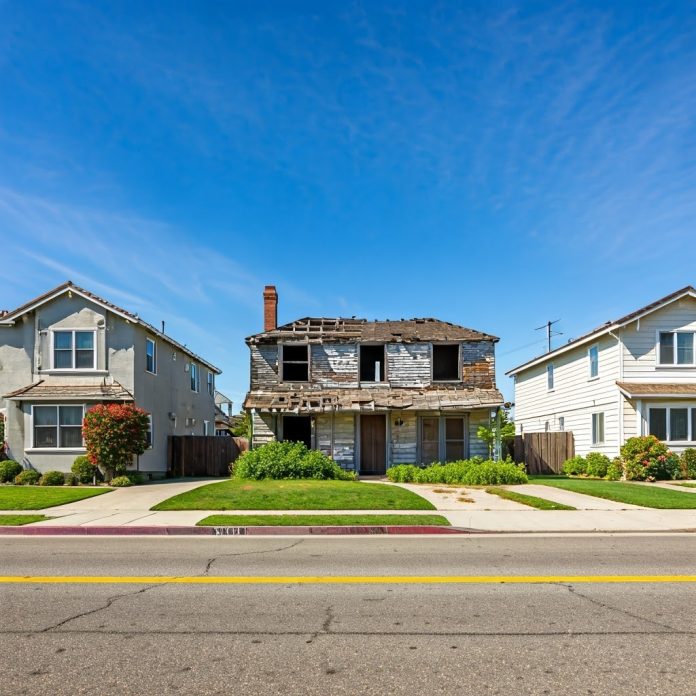“Look for the worst house in the best area!” Real estate economists scream it from their virtual “rooftops” at every opportunity, and realtors back them up, telling their homebuyers daily, “Location, location, location, that’s all that counts!” Guaranteed, if you’re searching for a first residence, looking to sell and upgrade, or selling to downsize, you’ve heard that same tune multiple times.
Our controversial position on one of the longest-standing go-to milestones for homebuyers is this: Frankly, it’s a shallow and confusing message with holes riddled all over it, let alone misleading advice. If that’s caught your attention, read on, and we’ll convert any skepticism into belief.
How bad can the “worst” really be?

Let’s begin with the events and circumstances that may lead to a single-family residence or condo being the “worst.”
- Perhaps someone committed suicide in it, the previous owners experienced a death right there in one of the bedrooms, or an occupant fell fatal victim to a violent break-in. It happens, and when it does, the ghosts never seem to disappear, connecting the home to an undesirable eeriness.
- Here are other realistic situations creating “neighborhood’s worst” addresses:
- In 2007, several homeowners discovered that they lived in gorgeous showpiece estates constructed with contaminated material known as Chinese drywall. The latter was an import that smelled, malfunctioned, and corroded everything around it, including plumbing, electricals, and appliances.
- Builders applied it extensively throughout the country’s upcoming communities, oblivious to what they were letting the residential marketplace in for.
- The stigma lingered even after tedious litigation (not always successful for hapless buyers) and remedial action that required stripping structures to the studs and replacing every metal content item.
Two examples in South Florida are:
- The HOA of Villa Lago (now Vizcaya Lakes) in Boynton Beach discovered over a hundred units in the building with the defective material.
- The Oaks, a swanky resort-style single-family development in Boca Raton – million-dollar-plus houses in a highly desirable community – contained several Chinese drywall homes.
The take-home value: If this has done anything to move the conversation along, you should know that flying in to buy the lowest-priced, “worst house” in the neighborhood without due diligence is a rash and unwise decision. Are you at least intrigued? If so, there’s much more we have to say on the subject.
So, why are homebuyers still chasing the worst houses?
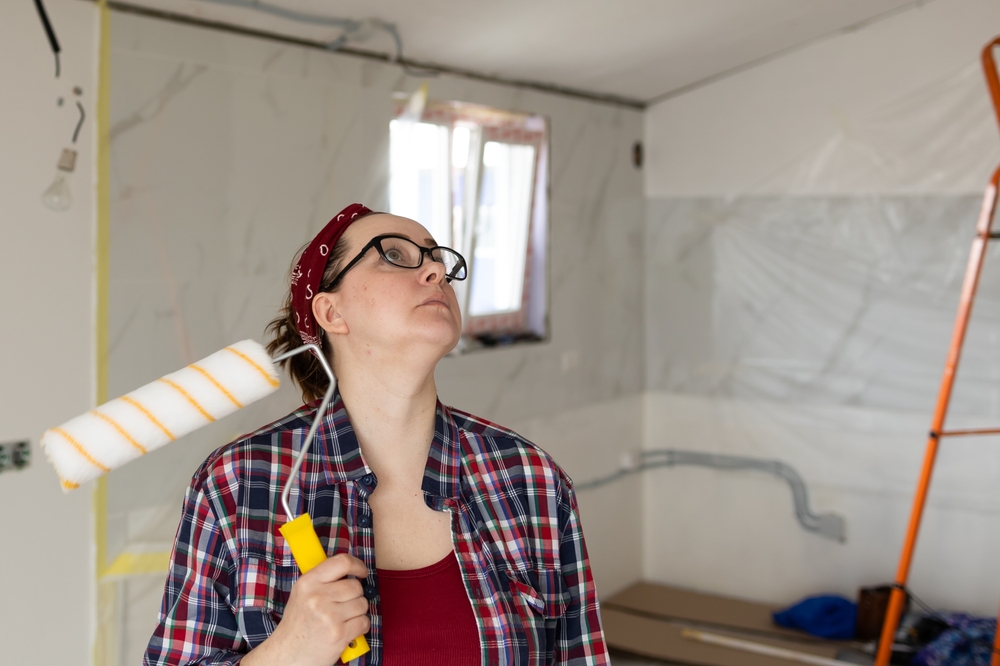
The answer is quite simple. Many unswervingly believe that it’s enough to find a prestigious neighborhood, that the cheapest house in that community aligns with unbeatable bargain value, that all you have to do is negotiate the targeted sellers as low as possible, and Voila! You’re in the ringside seats. In other words, the most appreciation potential has fallen in your lap, and you’ve entered real estate Shangrilla through a door someone carelessly left ajar. Now, all this may happen once in a blue moon, but the process as described likely won’t result in an intelligent purchase.
The take-home value: We’re sure you’ve heard the saying, “Leave no stone unturned.” Well, it applies here in spades. Unless you turn every stone over three times, clean them thoroughly, and turn them over again, you may be caught in a cash trap instead of a cash cow when you try to sell your property in the future.
What about “My family’s comfort” – the other part of the topic under discussion?

Great question. Here’s where we throw a spanner in the works. If your goal is to hob-nob with the relatively rich and famous, live next door or close to members of your aspiration group, and give your kids the opportunity to socialize and go to school with semi- or undisputed elitists, you may say, “To heck with investment value, I want lifestyle fulfillment.” Then, yes, the cheapest house in the most prestigious neighborhood is a viable entry strategy. It’s an eccentric take on things – not one that makes long-term sense.
The take-home value: Living low-key and less ostentatiously doesn’t mean sacrificing creature comforts or failing to live by family values that matter. We’ll explain why below.
Big data holds the secret to a better way.
There’s no residential data source quite like Zillow.com’s. In this article, we refer to the book Zillow Talk: The New Rules of Real Estate by Spencer Rascoff and Stan Humphries. Why? They took this long-held ‘worst house, best neighborhood” adage and tore it to pieces, brick by brick. How?
The Zillow founders developed incredible analytics focused on three things:
- US metro areas, pinpointing thousands of neighborhoods.
- Calculating over time:
- The average price trends of all homes in each.
- The same for their cheapest ten percent (i.e., bottom feeders).
- Comparing (a) to (b), thus proving (or disproving) the firm believers’ theory that the low 10% should outpace the greater average every time.
The results surprised everyone:
- The price appreciation of the 90% neither beat nor lost to the 10% in almost all of the oversights in every zip code.
- In other words, the averages for the majority and the minor low-priced home category were the same across the board.
The take-home value: The social climbing homebuyers cited above may be relieved to learn going cheap won’t harm them severely when selling down the line. However, getting the leg-up on appreciation value over the community’s nicer and initially more expensive houses? Forget it.
“Wait, there’s more to this than meets the eye,” say the Zillow people.
The data went on to reveal an insight shocker that rattled the pundits’ cages. It showed that homebuyers’ efforts to enter the best (i.e., the nicest or most prestigious) neighborhood wasn’t a savvy investment decision from any angle. Why?
- Ritzy suburb average values appreciated less rapidly than the average of all regional zip codes (representing the majority).
- In short, the neighborhood variances mattered most, not the house differentials inside the neighborhood.
THIS ARTICLE’S MOST MONEY-MAKING TIP: 
If you want to follow in the footsteps of the savviest homebuyers, target the cheapest houses in the “hottest” suburbs – not the “best” – to get maximum mileage for your buck. What’s the difference?
“Hottest” is not the “richest, nicest, or most prestigious” location in the region. It pointedly relates to residential communities reflecting:
- The most upside potential – those stamped as “diamonds in the rough.”
- Renovation activity or new development replacing old. In other words, regeneration on the edge of the plushiest section of town.
- Price levels in the lower half of the regional average yet showing an accelerated appreciation rate, promising a fast breakthrough into the upper fifty percent.
So, once and for all, kick the myth of “the nicer or richer the neighborhood is, the better” to the curb. Even if you buy a middle-priced house in an average suburb, you will still outpace the bottom ten percent of price buyers in the swankiest zip codes. Patience is the secret to real estate success, relying on careful due diligence and sound reasoning today to create wealth tomorrow. Let the rewards come to you under its own momentum instead of chasing it.
Where do I get this data, and how do I use it?
It’s not rocket science. Zillow’s online trend lines, suburb by suburb, are second to none.
For example, see two neighboring suburbs in South Florida versus their county as follows: 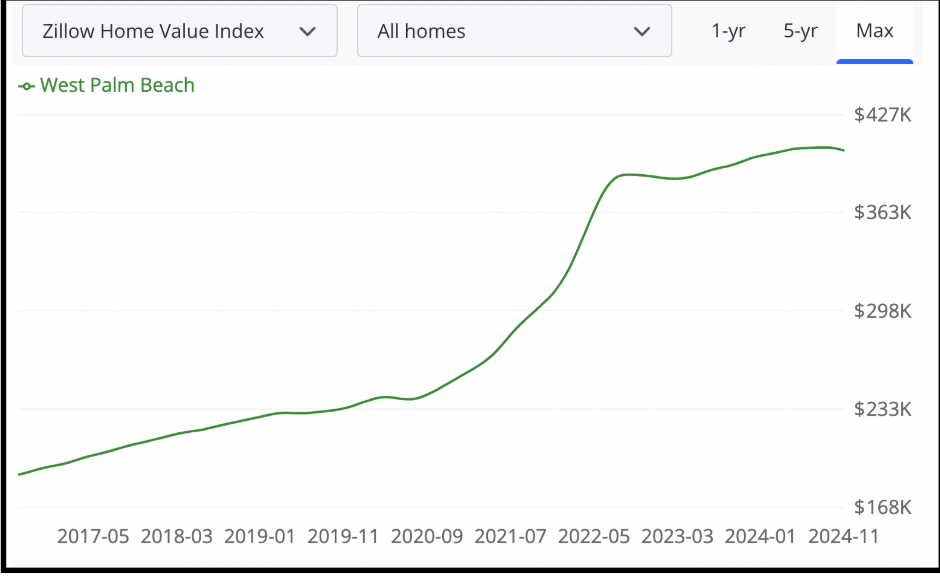
West Palm Beach County, FL
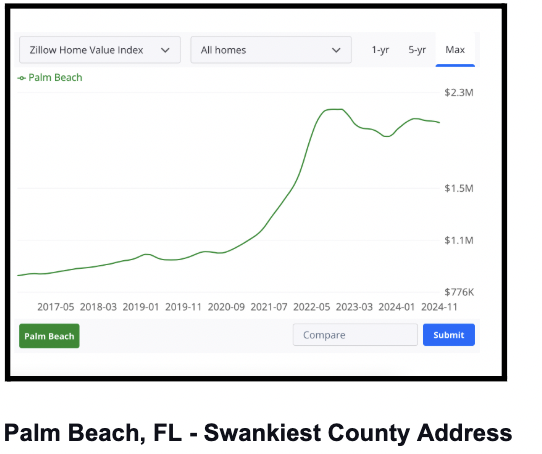
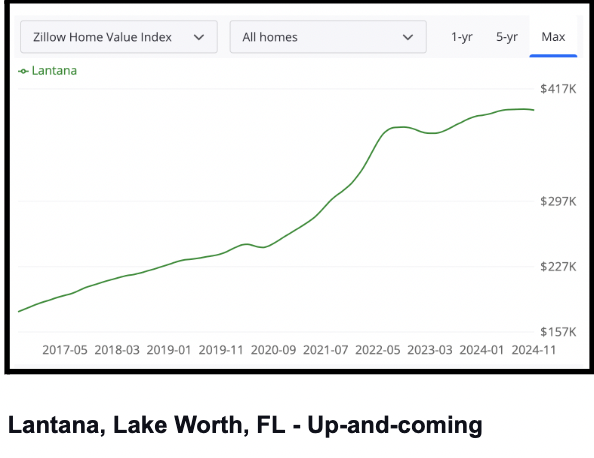
All images courtesy of Zillow derived from https://www.zillow.com/home-values/12311/lantana-lake-worth-beach-fl/ – https://www.zillow.com/home-values/21195/wellington-fl/ – https://www.zillow.com/home-values/7858/west-palm-beach-fl/
- Lantana’s pricing trend lags the overall average yet looks robust, signifying “hot” zip code characteristics.
- Palm Beach is way above the county average prices, but its trend looks lackluster. Buying the worst home in this town may be a cash trap or less than optimal (as explained above).
Similarly, you can compare cities in different states if you view the entire country as presenting investment opportunities. For example:
- According to Zillow, the average home price in Boise, Idaho, at the end of 2024 was $482,666, up by $118,204 in four years from $364,462 – an increase of 32.4% (or 6.35% compound growth annually).
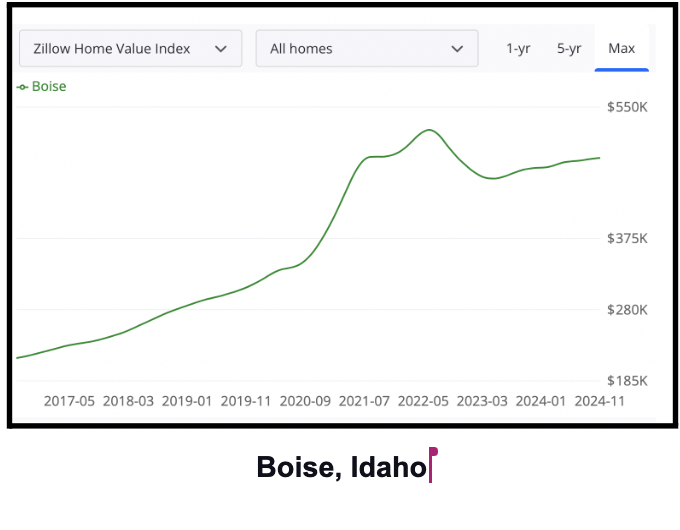
- Over the same period, Miami showed a remarkably similar average home value in 2020 ($364,384). However, it demonstrated a significantly higher price escalation over the same period as we enter 2025 at $584,567 – a 60.4% bump (1.86 times Idaho’s real estate appreciation) and nearly double its compound growth rate.
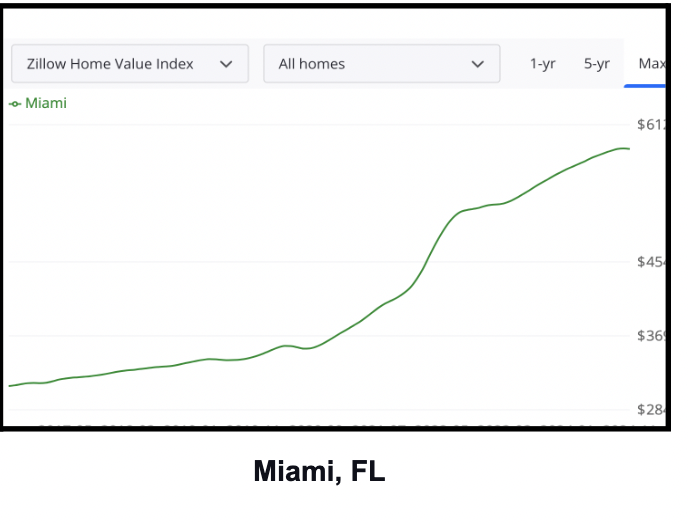
Both cities offer homeowners modern metropolitan conveniences, such as nearby shopping, healthcare, and public/private education centers. Each prides itself on integrated religious, lifestyle, cultural, and entertainment options, sports participation, neighborhood safety, seamless and fast transport, and vibrant social connection. However, with 20/20 vision, Miami was hot, and Boise was not.
Savvy investors in 2020 had to dig further to find out why and nab a bargain. One thing’s for sure: the winners know it had nothing to do with the conventional wisdom of looking for the cheapest house in the best neighborhood.
Conclusion and FAQs
The most successful route to capital appreciation without sacrificing family comfort is to:
- Zone in on the lower-priced neighborhoods adjacent to the already-affluent ones.
- Never lose sight of a striking trend toward buying fixer-uppers (although not the mind-boggling bargains they used to be):
- The older the community with seamless connection to metro conveniences, the higher the probability of its homes appreciating.
- It may involve some renovation, but it should yield a significant return on your outlay over time (especially if leveraged).
- Use cost per square foot under-air and Zillow’s (suburb-by-suburb) up-to-date trend lines (see examples above) as a reliable guide.
- Talk to experienced realtors, access online educational podcasts on the subject, and keep up with the trends in your city.
In short, spot the genuine price drivers hiding in plain sight, and you’re off to the races. Erase the worst house in the best neighborhood from your thinking – it doesn’t help you make better homebuying decisions.
FAQs
Q1: Why doesn’t looking for the worst house in the best area make sense?
A: The notion is too general, and big data indicates one should instead aim for the cheapest house in the most up-and-coming zip codes.
Q2: Who or what is the data authority in the worst house, best neighborhood conversation?
A: Zillow.com
Q3: If the “worst house, best neighborhood” doesn’t work, what should I do instead to buy my home wisely?
A: Four things:
- Zone in on the lower-priced neighborhoods adjacent to the already-affluent ones.
- Never lose sight of a striking trend toward buying fixer-uppers (although not the mind-boggling bargains they used to be):
- The older the community with seamless connection to metro conveniences, the higher the probability of its homes appreciating.
- It may involve some renovation, but it should return multiple times your outlay.
- Use cost per square foot under-air and Zillow’s (suburb-by-suburb) up-to-date trend lines (see examples above) as a reliable guide.
- Talk to experienced realtors, access online educational podcasts on the subject, and keep up with the trends in your city.
Q4: What was the most groundbreaking insight Zillow’s data provided around this topic?
A:
- Ritzy suburb average values appreciated less rapidly than the average of all regional zip codes (representing the majority).
- In short, the neighborhood variances mattered most, not the house differentials inside the neighborhood.
Q5: What’s the most valuable pointer this article offers readers?
A: If you want to follow in the footsteps of the savviest homebuyers, target the cheapest houses in the “hottest” suburbs – not the “best” – to get maximum mileage for your buck.

